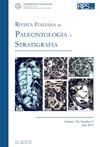NEW FOSSIL LACEWING LARVAE WITH TRUMPET-SHAPED ELONGATE EMPODIA PROVIDE INSIGHT INTO THE EVOLUTION OF THIS ATTACHMENT STRUCTURE
IF 1.6
3区 地球科学
Q2 GEOLOGY
引用次数: 0
Abstract
The larval life phase often represents the major share of the life span of holometabolans, such as beetles or flies. Therefore, knowledge of these larvae is crucial concerning ecological functions, but also concerning the evolutionary history of the different groups. In the holometabolan group Neuroptera (lacewings), larvae have numerous specialisations, among them the venom-injecting mouthparts, the stylets. Another such very characteristic feature of many lacewing larvae is the empodium, an attachment structure at the tip of the leg, which varies in shape in the larvae of the different lacewing groups. One type of empodium is the elongate trumpet-shaped type, which is found in several lacewing groups today as well as in many fossil representatives, especially well visible due to preservation in amber. Based on the pattern of phylogenetic distribution of the elongate trumpet-shaped empodium, different reconstructions of the evolution of this structure have been put forward, some suggesting possibly convergent evolution, others repetitive losses. In this study, new lacewing larvae preserved in 100-million-year-old amber from Myanmar are presented, which expand the number of lineages with an elongate trumpet-shaped empodium. Based on these new data, the implications on the evolutionary history of the different lineages within Neuroptera are discussed. The fossils demand for an earlier evolution in some reconstructions, but especially for more and later losses of this structure.新发现的具有喇叭形细长喙的草蛉幼虫化石有助于了解这种附着结构的进化过程
幼虫阶段往往是甲虫或苍蝇等整体代谢类动物寿命的主要阶段。因此,对这些幼虫的了解不仅对其生态功能,而且对不同类群的进化史都至关重要。在全翅类的神经翼虫(草蜻蛉)中,幼虫有许多特化特征,其中包括毒液注射口器--花柱。许多草蜻蛉幼虫的另一个非常显著的特征是腿顶端的附着结构,不同草蜻蛉类的幼虫腿顶端的附着结构形状各异。其中一种是细长的喇叭形后腿基,这种后腿基在当今的几个草蜻蛉类群和许多化石代表中都有发现,由于保存在琥珀中,这种后腿基尤其清晰可见。根据细长的喇叭形齿状突起的系统发育分布模式,人们对这种结构的进化提出了不同的重建方案,有的认为可能是趋同进化,有的则认为是重复损失。本研究展示了保存在缅甸 1 亿年前琥珀中的新草蜻蛉幼虫,这些幼虫扩大了具有细长喇叭形尾甲的世系数量。在这些新数据的基础上,讨论了对神经目不同品系进化历史的影响。这些化石表明,在某些重建中,这种结构的进化时间较早,但尤其是在更多的时期,这种结构的消失时间较晚。
本文章由计算机程序翻译,如有差异,请以英文原文为准。
求助全文
约1分钟内获得全文
求助全文
来源期刊
CiteScore
3.60
自引率
4.30%
发文量
28
审稿时长
>12 weeks
期刊介绍:
The Rivista Italiana di Paleontologia e Stratigrafia was founded in 1895. It publishes original papers dealing with all fields of paleontology and of stratigraphy, from Italy and the Mediterranean to the Tethys, as well across the globe from China to North America.

 求助内容:
求助内容: 应助结果提醒方式:
应助结果提醒方式:


